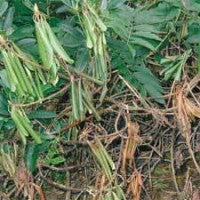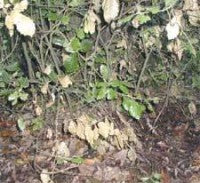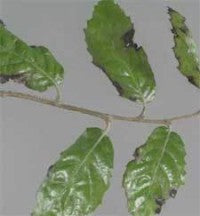"Sudden Oak Death" - Phytophthora ramorum
"Sudden Oak Death" - Phytophthora ramorum
By Laurence Gale
There has been a lot of recent news about Sudden Oak Death in the national press, with DEFRA inspectors finding a small number of disease outbreaks in garden centres and nurseries. Positive findings have been made in rhododendron. vibernum and other exotic shrubs, and the infected plants have been destroyed and none of the batches from which they came has been sold.

Phytophthora ramorum is the pathogen associated with the disease currently affecting tan oak trees on the west coast of the USA. Symptoms of disease caused by Phytophthora ramorum were first noticed on rhododendron in Europe in 1993, although the causal pathogen was not identified until 2001. Subsequent surveys have shown it to be present in at least nine European countries, including the UK. Emergency measures against the introduction and spread of P. ramorum were introduced throughout the EU in November 2002, replacing the UK's emergency legislation put in place in May 2002. The EU will be reviewing its measures, and will be studying survey reports from all member states. The first confirmed UK case of disease on trees, found on a single southern red oak tree (an American species) was announced on 5 November 2003.
Forestry Commission scientists have identified the link between the European findings of the disease and the outbreaks in the USA. which as led to DEFRA and the Forestry Commission banning imports of certain plants, notably oak trees, rhododendron and viburnum, from certain areas of California and Oregon and requiring new controls of wood to protect the country from a disease which is ravaging forests in parts of the USA. These measures are being taken on a precautionary basis, because the potential impact of the US strain of this disease on European species of oak is unknown.

Sudden Oak Death is caused by a microscopic fungus - Phytophthora ramorum - which has been shown to cause the deaths of tan oak trees and some other species in California. But the oak tree species are not the same as those found in Europe. Research is continuing into the means of spread of the fungus and the host range. All nine trees infected in the UK are surrounded by diseased rhododendrons; in the US, the tanoaks were surrounded by bay laurel. Vigilance on the part of nurseries importing and producing plants as well as reports of unusual disease symptoms by members of the public will help protect domestic production and the wider environment.
The Forestry Commission and the Central Science Laboratory are carrying out research into the susceptibility of European oaks and other trees to both the European and American strains. So far English oaks appear to be more resistant to the disease than American oak species but beech and chestnut are susceptible. But until the research establishes susceptibility there is concern that the disease could cause major damage to native species.

Infection is thought to begin in the outer bark of trees and shrubs, leading to girdling and rapid wilt. The fungus is believed to be a cool temperate organism with a minimum temperature for growth of 2ºC and a maximum of 26-30ºC. The means of spread may be locally by rain splash from rhododendrons, wind-driven rain, irrigation water and possibly aerially. Long distance spread may be by movement of contaminated plant material, growing media and in soil carried on vehicles, machinery, footwear, animals etc. The only known control is to burn all affected / diseased material.
Symptoms
-
In Viburnum, infection begins at the stem base and causes the plants to wilt and collapse very quickly. Individual stems might be affected.
-
In rhododendron, the fungus causes a twig and leaf blight, symptoms of which are most pronounced in summer. Affected twigs develop a brown to black discoloration, usually starting at the tip and moving towards the base. Infected leaves show dark brown blotches.
-
In oak (NB no oaks have been found infected in the UK or Europe), bleeding cankers develop, often on the lower portions of the trunk, but sometimes several metres up the stem. Removal of the bark reveals mottled areas of necrotic, dead and discoloured inner-bark tissue. The DEFRA or Forestry Commission web-sites have more details.
 Until more is known about the biology of the organism and the susceptibility of European species of plants it is difficult to give an accurate assessment of risk. Should the European strain prove as damaging as the US strain, or should the US strain arrive and prove as damaging here as in the USA, substantial damage to commercial plant production and native forests could be caused. For that reason a cautious approach is being adopted until more is known.
Until more is known about the biology of the organism and the susceptibility of European species of plants it is difficult to give an accurate assessment of risk. Should the European strain prove as damaging as the US strain, or should the US strain arrive and prove as damaging here as in the USA, substantial damage to commercial plant production and native forests could be caused. For that reason a cautious approach is being adopted until more is known.
If sudden oak disease was to become established in our woodlands, it is unlikely that it could be eradicated. That's why we believe our precautionary approach is the right one. We don't believe the disease is established here. There have been a small number of cases involving only a few plants in each one. These have all been destroyed. Our new notification requirement will allow us to reinforce vigilance.
For more information on Phytophthora ramorum see:
- news release 513/03, issued jointly by Defra and the Forestry Commission
- The Forestry Commission website (www.forestry.gov.uk/pramorum)
- The plant health pages on this site (www.defra.gov.uk/planth/oak.htm)
